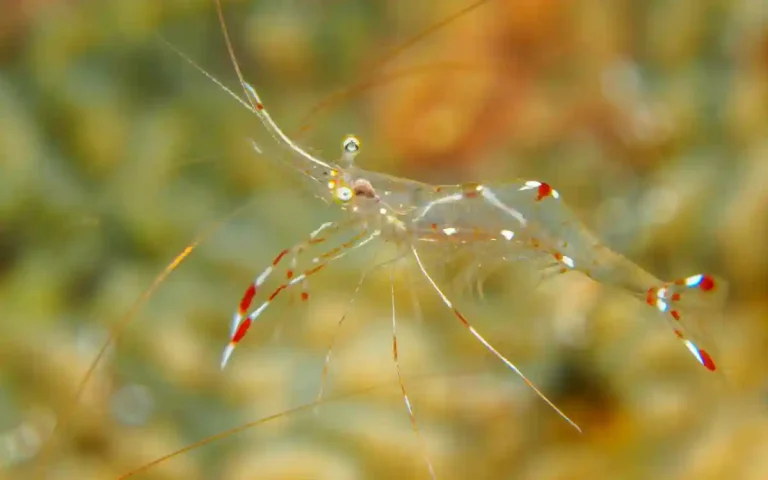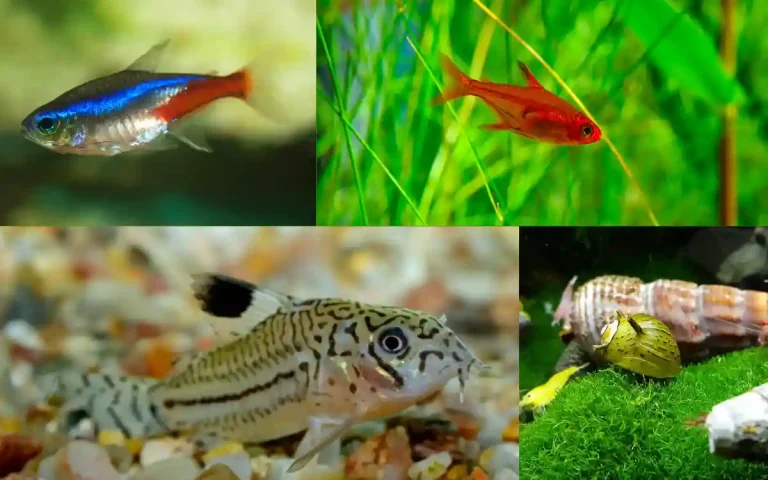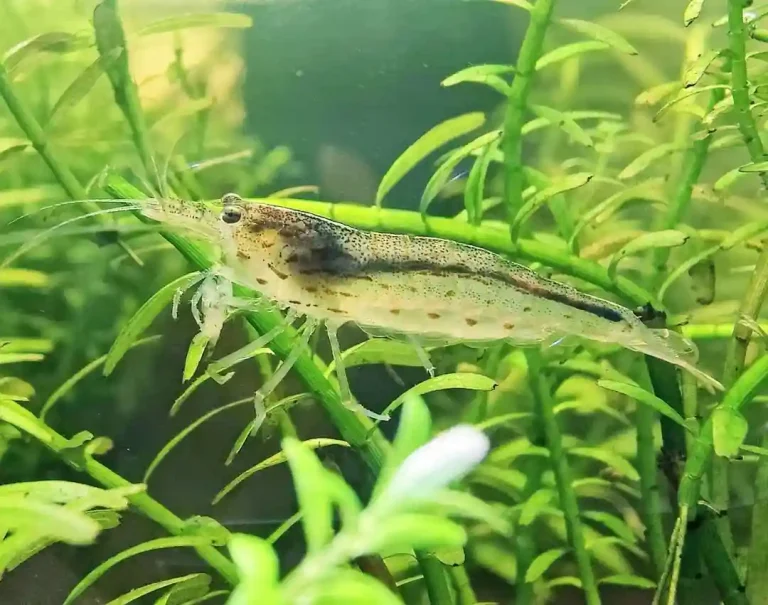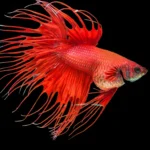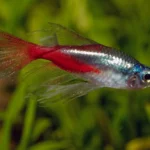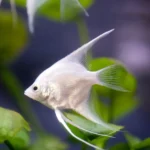Cherry shrimp are small, peaceful freshwater shrimp that make a colorful addition to planted aquariums. They are easy to care for, making them a popular choice for beginners and experienced aquarists alike. To keep cherry shrimp healthy, you need a stable tank setup with clean water, gentle filtration, and plenty of plants or hiding spots. These shrimp thrive at temperatures between 68°F and 78°F, with a pH between 6.5 and 7.8. They feed on algae, biofilm, and shrimp-specific foods, and can even help clean your tank. With proper care, cherry shrimp can live up to two years and breed regularly, creating a lively, self-sustaining colony.
What Are Cherry Shrimp? (Neocaridina davidi Basics)
Cherry shrimp (Neocaridina davidi) are small, peaceful freshwater shrimp known for their bright red color. Originally from Taiwan, they have become one of the most popular shrimp species for home aquariums. Cherry shrimp are often chosen for planted tanks because they help control algae and eat leftover food, keeping the tank clean.
These shrimp are part of the Neocaridina family and are famous for being hardy and adaptable, making them great for beginners. They can handle a range of water conditions, but stable, clean water is key to keeping them healthy and showing off their bright color.Cherry shrimp are often compared to other shrimp species, like Crystal Red Shrimp. While both are beautiful, cherry shrimp are easier to care for and more tolerant of different water conditions. If you want to explore another colorful option, check out our full Crystal Red Shrimp Care Guide.
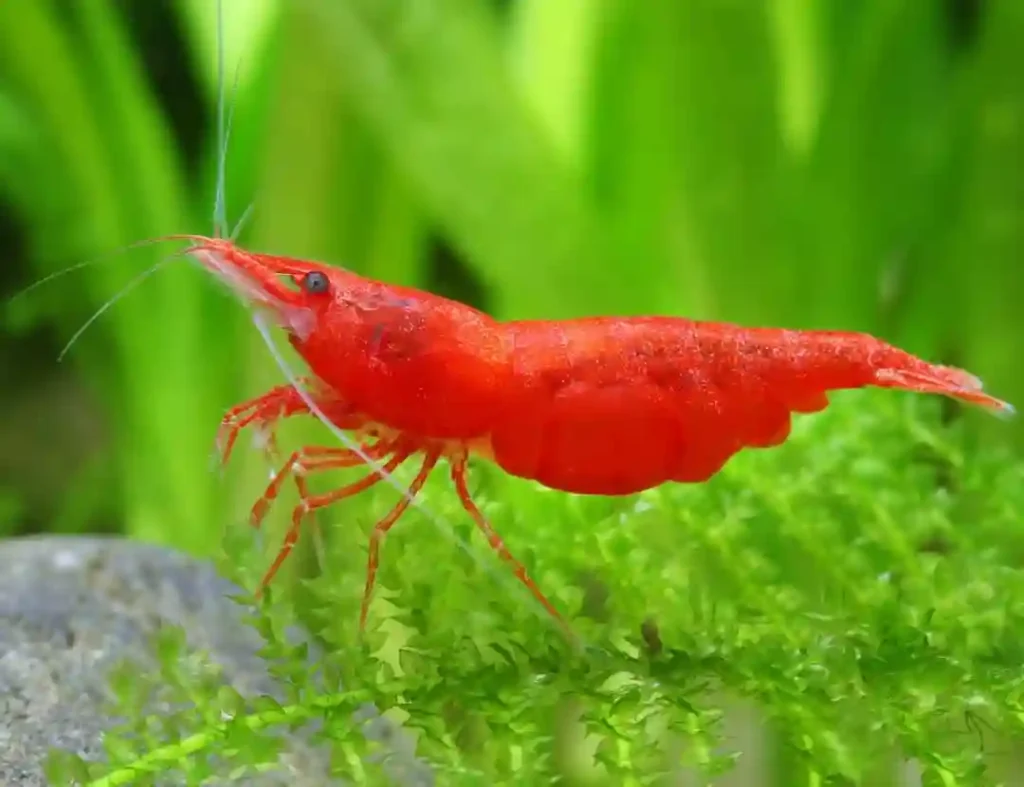
Cherry Shrimp Quick Care Facts
| Feature | Details |
| Size | Up to 1.5 inches |
| Lifespan | 1–2 years |
| Temperature | 68–78°F |
| pH | 6.5–7.8 |
| Tank Size | Minimum 5 gallons |
| Diet | Algae, biofilm, shrimp pellets, blanched veggies |
| Behavior | Peaceful, active scavenger |
Cherry Shrimp Appearance and Color Grades
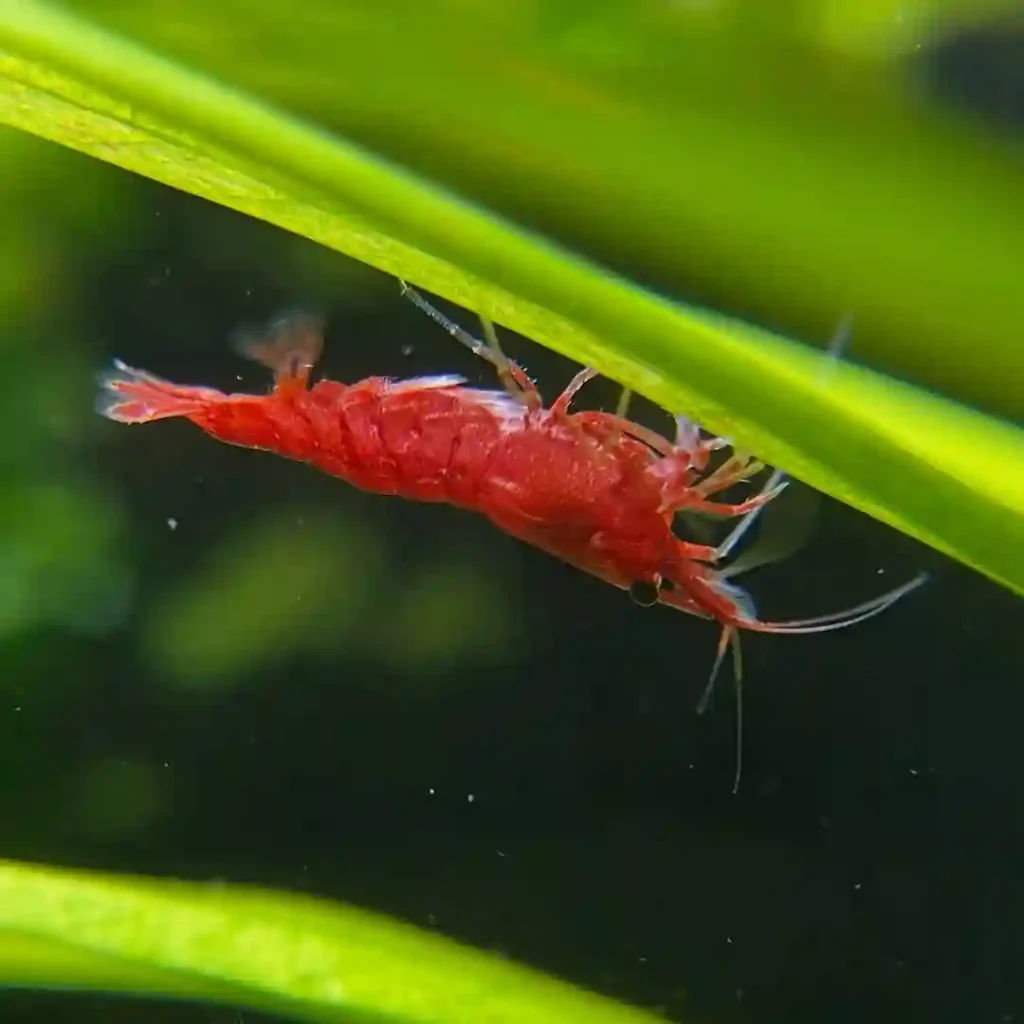
Cherry shrimp are best known for their bright red color, which adds a splash of beauty to any aquarium. But not all cherry shrimp are the same shade of red. Breeders have developed different color grades that describe how deep and even the red color is across the shrimp’s body.
The basic grade is a lighter red with some clear patches on the body. As the grades go higher, the red becomes richer and more solid. For example, Sakura Cherry Shrimp have a strong red color with fewer transparent areas, while Fire Red and Painted Fire Red shrimp are almost entirely deep red, including the legs.
Water quality, diet, and genetics all play a role in how bright your shrimp appear. A healthy, stable tank with plenty of natural food like biofilm can help your shrimp keep their color. Special shrimp foods that include color enhancers may also improve their appearance over time.
Cherry Shrimp Tank Setup: How to Build the Perfect Home
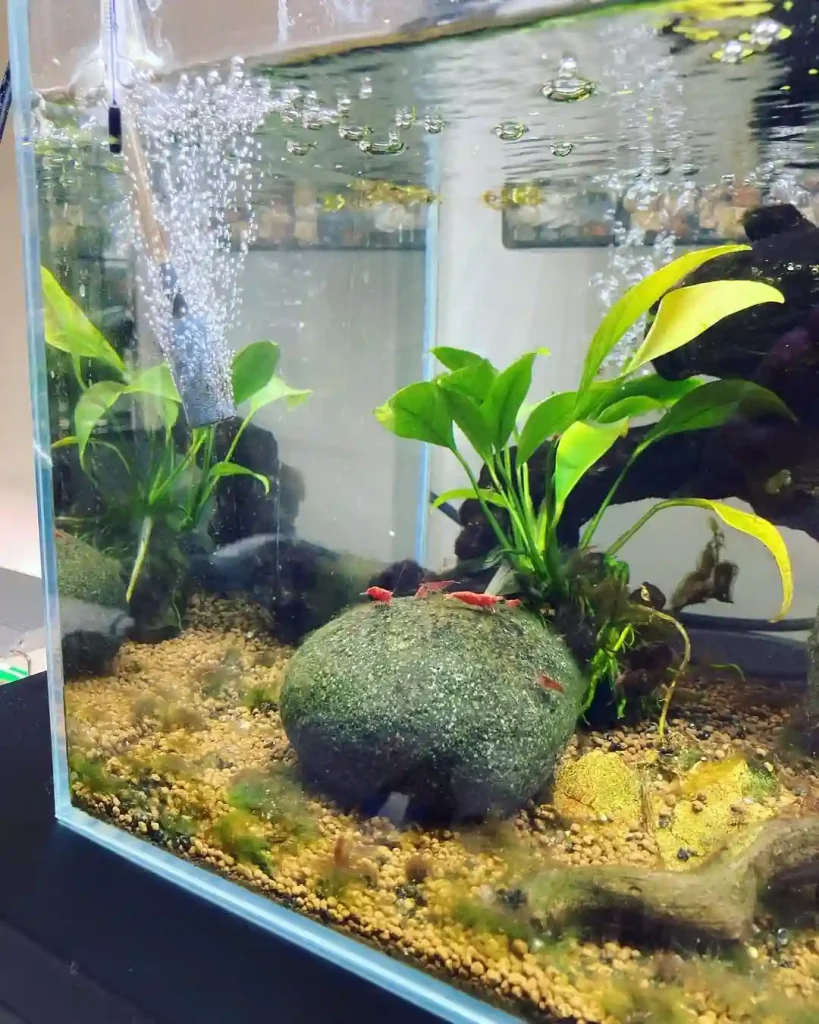
Cherry shrimp do best in a peaceful, stable environment. While they are small, they still need enough space to swim, graze, and hide. A tank that holds at least 5 gallons is the minimum for a small group, but a 10-gallon or larger tank is even better. Larger tanks help keep water conditions stable, which is important for these sensitive shrimp.
Water parameters matter a lot for cherry shrimp health. They thrive in temperatures between 68°F and 78°F, with a pH between 6.5 and 7.8. The water should be clean, with low levels of ammonia and nitrite. A gentle sponge filter is a good choice because it keeps the water clean without creating strong currents that might stress your shrimp. If you’re wondering whether a filter is necessary, check out our guide: Do Shrimp Need a Filter?.
Adding live plants is a great idea. Plants like mosses, ferns, and floating species provide shelter and encourage the growth of biofilm, which is a natural food source for your shrimp. The right plants also help make the tank feel safe and give baby shrimp places to hide. If you’re thinking about keeping cherry shrimp in smaller tanks, read our article on Shrimp for Nano Tanks for more setup ideas.
Cherry Shrimp Diet: What Do They Eat?
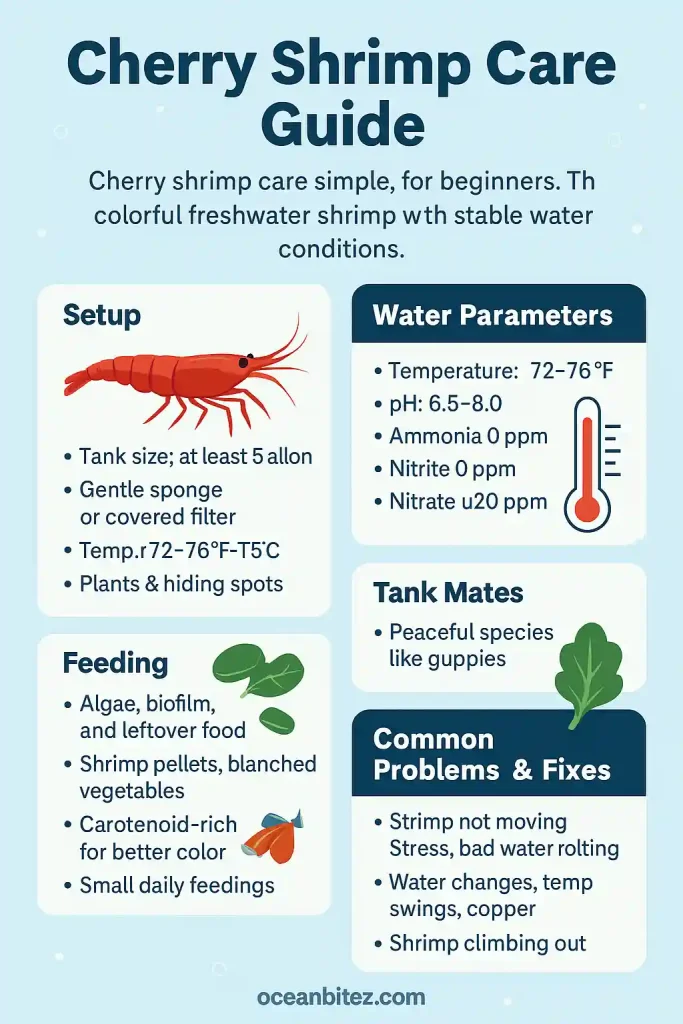
Cherry shrimp are natural scavengers that spend most of their time grazing for food. In the aquarium, they feed on biofilm, algae, and tiny particles they find on plants, rocks, and decorations. This helps keep the tank clean while giving them a steady food source.
While biofilm and algae are a big part of their diet, it’s important to give them extra food to make sure they stay healthy. You can feed cherry shrimp high-quality shrimp pellets, algae wafers, and blanched vegetables like zucchini or spinach. These foods provide essential nutrients and help support molting and color development.
Make sure not to overfeed. Uneaten food can pollute the water and harm your shrimp. Offer small amounts and watch how quickly they eat. Remove leftovers after a few hours to keep the water clean. A balanced diet will help your cherry shrimp grow well, stay active, and show their best color.
Molting and Health
Molting is a natural part of a cherry shrimp’s life. As they grow, they shed their old shell to make room for a new one. You might find these empty shells lying in the tank. Don’t worry—this is normal. Most shrimp molt every few weeks, though younger shrimp may do it more often.
After molting, cherry shrimp are soft and vulnerable. They will hide for a day or two until their new shell hardens. It’s important to have plenty of plants and hiding spots in the tank so they feel safe during this time.
Problems with molting usually happen when the water conditions aren’t right. If the water is too soft or lacks enough minerals like calcium, shrimp may struggle to form a strong new shell. To help, you can feed calcium-rich foods and keep the water’s hardness within the right range (GH 4–8).
If you notice failed molts (where shrimp can’t fully shed their shell), check your water parameters and diet. Stable, clean water and proper nutrition are the best ways to prevent health problems.
Cherry Shrimp Breeding Guide
Cherry shrimp are easy to breed if they have the right conditions. You don’t need to do much to encourage them. If your shrimp feel safe and the water quality is good, they will start breeding on their own.
A female cherry shrimp carries eggs under her tail, known as being “berried.” You’ll see tiny yellow or green eggs there. The female fans these eggs with her legs to keep them clean and well-oxygenated. The eggs usually hatch in about three to four weeks, depending on the water temperature.
When the baby shrimp hatch, they look like miniature adults. They will hide in plants and moss until they grow bigger. To help baby shrimp survive, make sure your tank has lots of hiding places and natural food like biofilm. It’s also a good idea to avoid keeping shrimp with fish that might eat the young.
Cherry shrimp can breed every few weeks in a healthy tank, so it’s important to plan for population growth. If you don’t want too many shrimp, you can give some to other hobbyists or add fish that will help control the baby shrimp numbers.
Tank Mates for Cherry Shrimp
Cherry shrimp are peaceful and small, so it’s important to choose tank mates that won’t see them as food. The best companions are other gentle creatures that won’t bother them. Snails, like nerite or mystery snails, are a safe choice. Small fish, such as ember tetras or celestial pearl danios, can also work as long as they are well-fed and kept in a peaceful community.
Avoid keeping cherry shrimp with fish that might nip or hunt them. Bettas, larger tetras, cichlids, and gouramis can see shrimp as snacks. Even small fish might eat baby shrimp if they get the chance. This is why heavily planted tanks are helpful—plants give baby shrimp places to hide and grow.If you’re curious how cherry shrimp compare to other species, check out our guide on Amano vs Cherry Shrimp. You’ll learn about differences in size, behavior, and tank compatibility.
Common Problems & How to Solve Them
Even though cherry shrimp are hardy, there are a few issues that owners often face. One common problem is color fading. This usually happens when shrimp are stressed or not getting the right nutrition. To help, check your water parameters, reduce stress from aggressive tank mates, and offer high-quality foods designed to boost color.
Another issue is when shrimp hide all the time. While it’s normal for them to seek shelter after molting, constant hiding can be a sign they don’t feel safe. Make sure there are no aggressive fish in the tank and add more plants or decorations so they feel secure.
You might also notice a sudden population boom. Cherry shrimp breed easily, and before you know it, you could have more shrimp than your tank can handle. To manage this, consider sharing extras with friends, selling to local hobbyists, or adding gentle fish that might help control baby shrimp numbers.
Keeping the tank clean, feeding a balanced diet, and watching for changes in behavior will help prevent most problems and keep your shrimp healthy.
Types of Shrimp to Consider Besides Cherry Shrimp
While cherry shrimp are a favorite for many aquarists, there are other freshwater shrimp species that can be just as interesting. Crystal Red Shrimp are another colorful choice. They have striking red and white patterns but need more stable, soft water conditions compared to cherry shrimp. If you’re ready for a bit more of a challenge, you can explore our Crystal Red Shrimp Care guide for more details.
Amano shrimp are larger and well-known for their algae-eating abilities. They’re a great choice if you want help keeping your tank clean. If you’re curious about how Amano shrimp compare with cherry shrimp in terms of size, diet, and care, see our Amano vs Cherry Shrimp guide.
There are also ghost shrimp, which are clear and a fun, budget-friendly option. Each shrimp species has its own needs, so it’s a good idea to research before adding them to your tank. You can explore more choices in our Types of Shrimp article.
FAQs
How many cherry shrimp should be kept together?
Cherry shrimp are social and feel more comfortable in groups. A good starting number is at least 10 shrimp. This helps them feel secure and encourages natural behavior like grazing and exploring.
Do cherry shrimp clean the tank?
Yes, cherry shrimp help keep the tank clean by eating algae, biofilm, and leftover food. However, they won’t replace regular tank maintenance like water changes and filter cleaning.
How long do cherry shrimp live?
With good care, cherry shrimp can live between one and two years. Stable water conditions and a balanced diet help them reach the upper end of this lifespan.
Can cherry shrimp live with bettas?
It depends on the betta’s personality. Some bettas will ignore shrimp, while others may see them as food. If you try this pairing, make sure there are plenty of hiding spots and monitor their behavior closely.
Do cherry shrimp need a heater?
If your room temperature stays between 68°F and 78°F, a heater might not be necessary. But if temperatures drop below this range, a heater will help keep the shrimp healthy and active.

